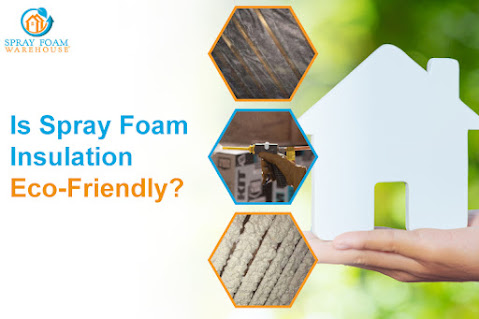Is Spray Foam insulation Eco-Friendly?
Homeowners are becoming increasingly conscious of the carbon footprint as environmental concerns grow and wisely investing in good house insulation is an excellent place to begin your eco-friendly journey. Insulating your home reduces your energy usage and, as a consequence, your environmental effect. Inquisitive customers want to know how insulation affects the environment and how much it costs in the UK. Some people believe you only have two choices: waste energy due to insufficient Spray foam insulation or expose the Planet to the ecological consequences of insulation materials. There are multiple kinds of insulation available today but you would want to be sure you are buying a high-quality product that considers its environmental impact from start to finish.
Main types of Spray Foam Insulation
a. Light Density Open-Cell spray foam
OSPF has the additional benefit of being flexible. Buildings can compress and expand over time as the weather changes. OSPF twists & adapts with every contraction & expansion due to its flexibility, reducing the necessity for reinstallation. OSPF is an excellent air and sound barrier, despite its inability to block vapors. Due to these characteristics, OSPF is commonly used for interior walls & most indoor applications.
b. Medium density Closed-Cell Spray Foam
Because of its hardness and density, SPF is more powerful than SPF at acting as both a liquid and air barrier.
SPF has the additional benefit of increasing the structural support of walls
and floors. Insulation can assist reduce energy expenses while also protecting
structures from the elements. A+ Insulation has over years of work providing
insulation services in the UK and has the skills and know-how to properly
install insulation for both residential and commercial structures.
Spray Foam Insulation Advantages
- Spray Foam Insulation is highly efficient and
saves roughly around 50% on your energy bills.
- Curates a fantastic Moisture Barrier
- Highly eco-friendly and poses no risk to
surroundings
- Noise Reduction Insulator
- Resistant to Pests and rodents
- Resists the Growth of insects, mold and
mildew.
Spray Foam Insulation Disadvantages
- Spray foam insulation often does not
completely fill all available cavities.
- Some homeowners may experience water damage as
a result of spray foam insulation.
- Spray foam insulation might shrink in some
cases.
- To do spray foam insulation right, you'll need
to have a lot of experience.
- Spray foam insulation cost UK installations might fall
short of the required R-value.
- Spray foam insulation is more expensive to
install than some other insulation choices.
Comparable Insulation Values
Attic Insulation: Buildings in cold
climates should have at least R-49 attic insulation, which is about 16 inches
of fiberglass insulation. In warmer climates, an R-38 or greater, or around
12′′ or more, is sufficient.
Wall Insulation: While the width of
the studs limits wall insulation, different materials provide greater or lesser
R-values. Fibreglass batts in light, moderate, and high-density products with
R-11 to R-15 ratings are now available for conventional 24 walls. Depending on
the type utilized, sprayed foam insulation in the very same wall cavity might
range from R-14 to R-28.
Floor Insulation: While there are
other factors to consider when insulating under floors, such as venting and
moisture issues, the US Department of Energy proposes an R-25 rating in cold
climates or an R-11 rating in warmer climates.
Traditional Spray Foam Alternative
One alternative is cellulose insulation
which can be placed as a loose filler, dense pack, or spray. Cellulose is often
constructed from recycled paper or other green fibers, and has a lesser R-value
than spray foam, indicating it shields less effectively. Borate-based flame
retardants are used to treat both cotton & cellulose insulation, and they
are not as lethal to people as halogenated flame retardants.
b. Insulation using
mineral wool
Mineral wool could be a useful choice
for some tasks. Mineral wool is among the oldest insulating materials, and it
can contain up to 90% recycled material. The use of formaldehyde as a binding
material in the production process is the main source of health issues.
However, most tests reveal that the final product contains no formaldehyde.
c. Fiberglass
Insulation
Spray-applied fiberglass is a recent
spray-applied substance. It does not require fire retardants and may be
utilized in some buildings where spray-applied cellulose would have been too
heavy. This fiberglass product's binder is also bio based and green.
DIY Spray Foam Insulation
Whether the spray foam insulation kit
is closed-cell or open-cell is a crucial consideration when estimating the
cost. Closed-cell foam is more stiff, stable, or compressed than open-cell
foam, formulating it as an excellent choice for insulating the interior of
walls and other locations where structural integrity is important. It's also
the more costly of the two alternatives.
Aside from its relative price, the main
advantage of open-cell spray foam is that it spreads after being sprayed. This
makes it an excellent choice for hard-to-reach areas in your home, such as
ceiling gaps and high-up fissures. It's also a nice soundproofing choice.
Remember that open-cell spray foam somehow doesn't insulate as well as
closed-cell spray foam.
Is Spray Foam insulation Eco-Friendly?
Spray foam insulation is soy-based spray foam insulation UK cost. Doesn't bio-based spray insulation sound wonderful?
Plants are non-toxic, recyclable, and biodegradable, while spray foam's
excellent insulating characteristics are retained. It only substitutes
about 15% of the substance, leaving 85 percent petroleum-based. The 'eco' in
eco-friendly spray foam insulation generally refers to the fact that it is
sprayed with water rather than ozone-depleting fluorocarbons. This does not
imply that it is entirely plant-based but less harmful to the environment.






Comments
Post a Comment